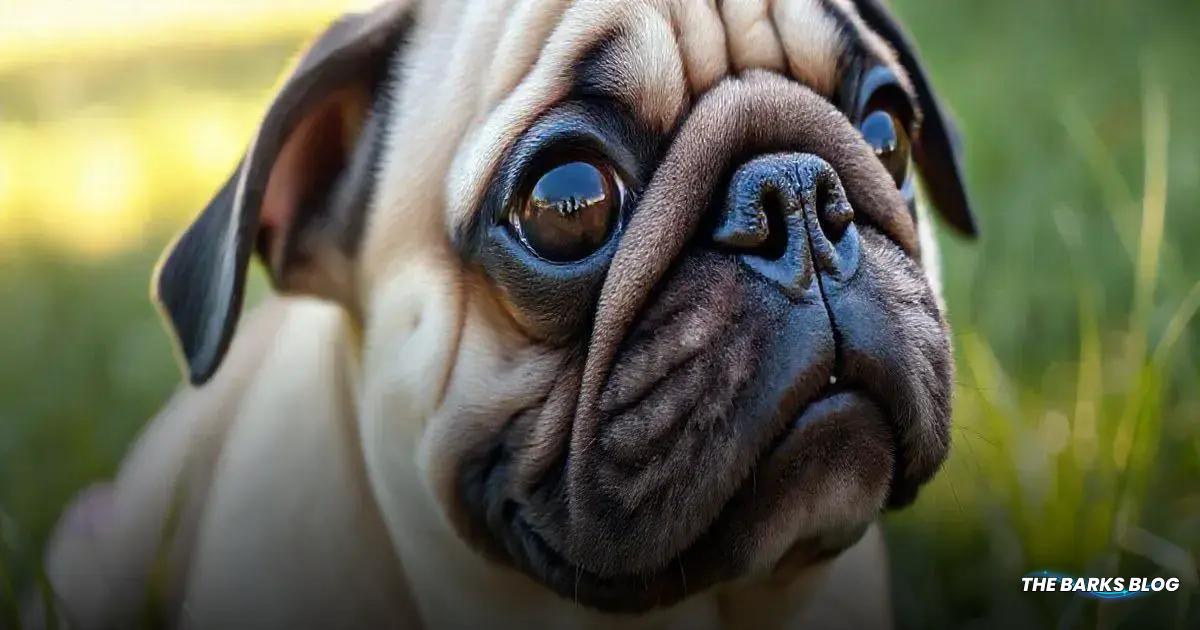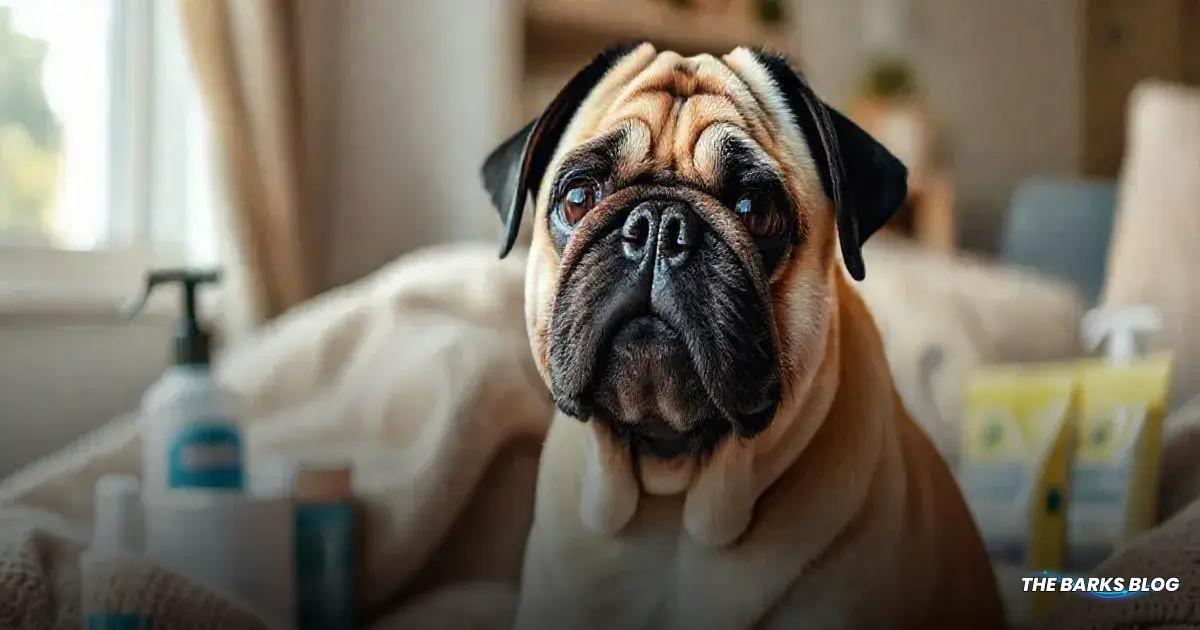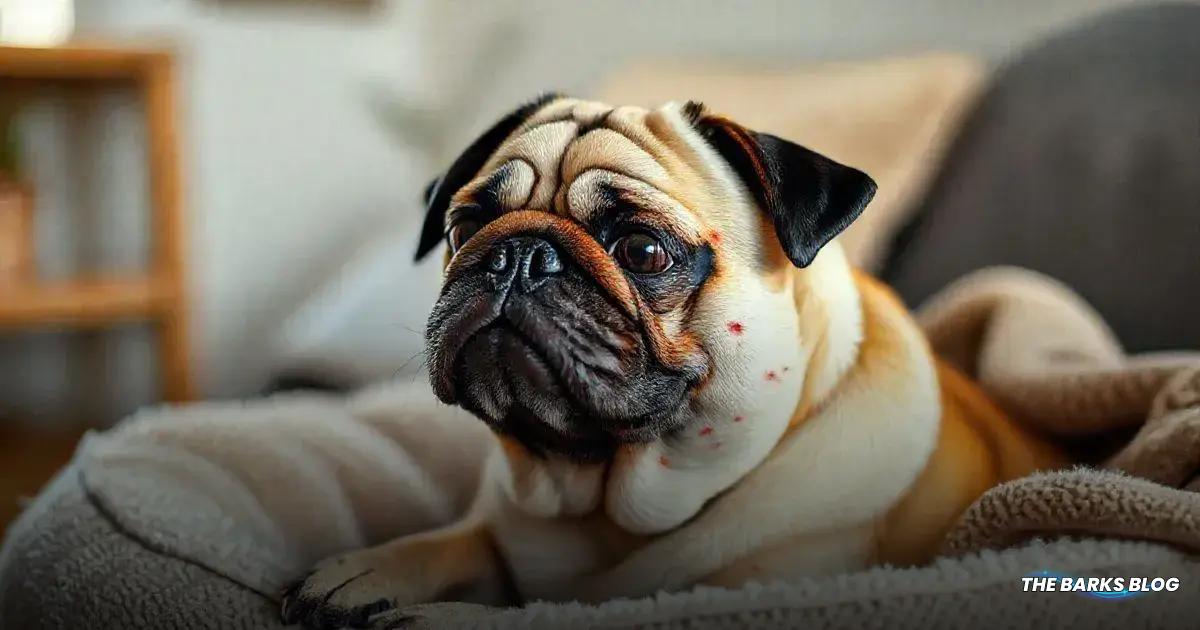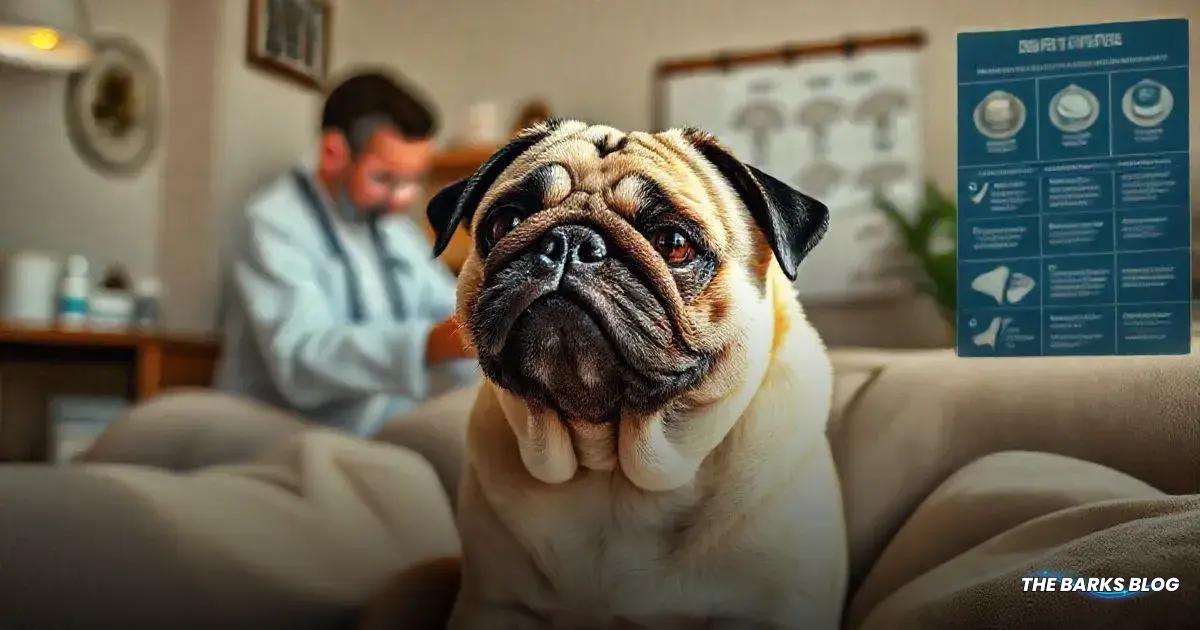Pugs are prone to skin problems such as skin fold dermatitis, allergies, and infections due to their unique physical traits. To manage these issues, regular veterinary checkups, proper hygiene, and hypoallergenic products are crucial. Pug owners should monitor their pets for skin problems and consult a veterinarian when needed to ensure their Pugs remain healthy and comfortable.
Pugs are beloved for their unique looks, but their distinctive features can lead to specific skin issues. Understanding pug skin problems is essential for every owner.

Understanding Pug Skin Problems
One of the ways the Pug has developed its unique face shape over the centuries is through what breeders would call a “foreshortened muzzle.” However, while the Pug muzzle and forehead may be short, the skin that covers it is not, giving the Pug its distinctive wrinkles, known in the medical world as “skin folds.”
While we humans may love smooshing those wrinkles, they come with special needs for care. Let’s look into some of the most common Pug skin problems that arise from these unique features.
It’s essential to recognize that Pugs are prone to various skin issues due to their anatomy. The folds in their skin can trap moisture and debris, creating a perfect environment for bacteria and yeast to thrive. This can lead to infections and irritations, making regular cleaning and veterinary check-ups crucial for maintaining their skin health.
Moreover, Pugs are also susceptible to allergies, which can manifest as skin irritations. Environmental factors, food, and even contact with certain materials can trigger allergic reactions, resulting in itching, redness, and discomfort. Understanding these risks can help Pug owners take proactive steps in managing their pet’s skin health.

Pug Skin Fold Dermatitis
Pug Skin Fold Dermatitis occurs when the skin inside of the folds is irritated by hairs and other skin rubbing together. This irritation can be exacerbated by the accumulation of skin secretions, leading to skin infections.
“Pugs are often considered the poster child for skin issues,” says Dr. Gavin Casper, Managing Veterinarian of General Practice at Hometown Animal Hospital in Weston, Florida. “Partially due to genetics, and partially due to confirmation, their wrinkles and short faces harbor moisture and create an ideal environment for bacteria, yeast, and allergens to accumulate, leading to skin infections.”
It’s crucial for Pug owners to be vigilant for the first signs of itching, as this could indicate that Pug skin fold dermatitis is at play. Regularly checking the folds of skin for redness, swelling, or foul odors can help catch potential problems early.
Veterinary intervention is often necessary when dermatitis occurs, as treatment may involve medicated wipes or ointments designed to reduce inflammation and prevent infections. Maintaining proper hygiene by cleaning the skin folds regularly with recommended products can significantly improve your Pug’s skin health.

Pug Skin Allergies
Pug Skin Allergies are a common issue that manifests as itchiness, skin irritation, rashes, hot spots, and even hair loss. It’s important to note that these allergies can be triggered by environmental factors or specific food ingredients.
Itchiness is often the first sign of a skin allergy in Pugs. Other symptoms may include red, inflamed skin and recurrent ear infections, which can also indicate an underlying allergy issue. Allergies can stem from various environmental allergens like pollen, dust mites, or mold, as well as food allergies linked to specific proteins.
“The most common causes of these signs include environmental allergens, such as mites or weeds, food allergies to proteins such as chicken or beef, or atopic dermatitis, which is dry and inflamed skin, similar to eczema in us humans,” explains Dr. Gavin Casper.
To diagnose environmental allergies, your veterinarian may suggest a serum test or intradermal skin test. If food allergies are suspected, your vet might recommend a novel or hydrolyzed protein diet to identify the offending ingredient. Once the allergens are pinpointed, strict avoidance becomes essential to prevent allergic reactions.
Managing Pug skin allergies often requires a comprehensive approach, including regular veterinary check-ups, appropriate medications, and lifestyle adjustments to minimize exposure to allergens. This proactive strategy can help keep your Pug comfortable and free from the discomfort associated with skin allergies.

Pug Skin Infections
Pug Skin Infections are a common concern, particularly for Pugs suffering from skin dermatitis. The constant low-grade irritation can lead to inflammation, creating an ideal environment for infections to develop, often referred to as Skin Fold Pyoderma.
Typical sites for Pug skin infections include the base of the tail, facial folds, and the vulva in female Pugs. The initial signs of these infections usually involve itching, rubbing, or chewing at the affected areas. “All these forms of pruritus, or itching, can lead to the second most common sign, redness and inflammation of the skin,” says Dr. Gavin Casper.
It’s crucial for Pug owners to monitor their pets closely for signs of infection. Early detection can make a significant difference in treatment outcomes. If you notice symptoms such as persistent itching, redness, or an unusual odor, it’s time to consult your veterinarian.
Your vet may recommend hydrocortisone wipes to reduce inflammation, along with medicated shampoos or creams to treat the infection. Regular cleaning of the affected areas can also help prevent the recurrence of skin infections.
Maintaining a proper hygiene routine and addressing any underlying skin issues promptly are essential steps in keeping your Pug healthy and comfortable. By being proactive, you can help minimize the risk of skin infections and ensure your furry friend stays happy.

5 Tips for Soothing Pug Skin Problems
5 Tips for Soothing Pug Skin Problems
The question remains, how to treat Pug skin problems? Being aware of the prevalence of skin issues in Pugs is half the battle. With the help of your veterinarian and lots of TLC, Pug parents can do a lot to keep their best friend’s skin healthy.
Regular Veterinary Checkups
Making sure a Pug is seen for preventive checkups is one of the most important steps any pet parent can take. “Pug parents must be proactive, watch for early signs of disease at home, and continue with regular wellness exams and bloodwork screening,” says Dr. Natalie Marks.
Veterinarians who care for Pugs will be on the lookout for signs of skin problems. Be sure to point out any common signs or symptoms you may see, including itchiness, skin tags, hot spots, and more. Take pictures of any changes in your Pug’s skin to illustrate the progression of the issue over time.
Bathing with Hypoallergenic Shampoo
Medicated shampoos and hypoallergenic shampoos are commonly recommended for dogs with sensitive skin. If you are using a medicated shampoo, specifically prescribed by your veterinarian, ask them about application instructions. Prolonged contact time is often needed, and rinsing thoroughly is crucial.
Avoiding Allergens
When it comes to the treatment and prevention of allergies, know that you are playing the long game. Environmental allergies require long-term management and regular veterinary examinations. While immunotherapy may be a great option, managing allergies will likely require additional actions such as cleaning your house more frequently to eliminate allergens.
If dietary allergies are suspected, pay special attention to treats, table scraps, and even toothpaste! Your dog should only eat the food and treats recommended by your veterinarian. Common allergens include beef, chicken, eggs, corn, wheat, soy, and milk.
Regular Cleaning of Wrinkles and Folds
“Regular cleaning and wiping of all folds or wrinkles with medicated wipes prescribed by a veterinarian can drastically maintain or improve skin health,” says Dr. Casper. This includes separating the skin fold and gently wiping inside the fold to keep the skin healthy and prevent infections.
Providing a Comfortable Living Environment
A recent study found that living environment can impact the skin health of dogs. Especially for those in urban areas, cleaning their coats from pollutants and microbes is essential. Ensure your Pug has access to soft, clean bedding, clean bowls, and plenty of love!
By following these tips and working closely with your veterinarian, you can help keep your Pug comfortable and healthy, allowing them to charm everyone they meet!
Final Thoughts on Pug Skin Issues
Pugs are popular for so many reasons: their friendly personalities, compact size, and of course, their adorable looks. However, responsible Pug owners know that this wonderful breed requires specialized care when it comes to their skin, nose, and overall health.
By grooming your Pug regularly and paying special attention to the skin care instructions given by your veterinarian, you can keep your Pug comfortable, healthy, and free from skin issues. Remember, early detection and proactive management are key to preventing more serious problems down the line.
With the right care and a little extra love, your Pug can continue to be the charming companion that brings joy to your life and those around you.
FAQ – Frequently Asked Questions about Pug Skin Problems
What are the common skin problems in Pugs?
Common skin problems in Pugs include skin fold dermatitis, skin allergies, skin infections, and skin tags.
How can I tell if my Pug has skin allergies?
Signs of skin allergies in Pugs include itchiness, redness, skin irritation, rashes, and recurring ear infections.
What should I do if my Pug has skin fold dermatitis?
If your Pug shows signs of skin fold dermatitis, consult your veterinarian for proper cleaning and treatment options.
How often should I bathe my Pug?
Pugs should be bathed as needed, typically every 4-6 weeks, using a hypoallergenic or medicated shampoo recommended by your veterinarian.
Can Pug skin problems be prevented?
Yes, regular veterinary checkups, proper hygiene, and avoiding known allergens can help prevent skin problems in Pugs.
What should I do if I notice black spots on my Pug’s skin?
Black spots, or hyperpigmentation, can indicate an underlying issue. It’s best to consult your veterinarian for an evaluation and appropriate treatment.




